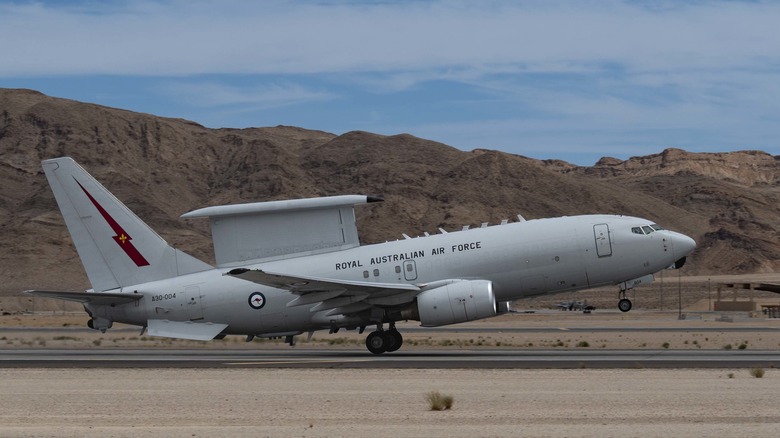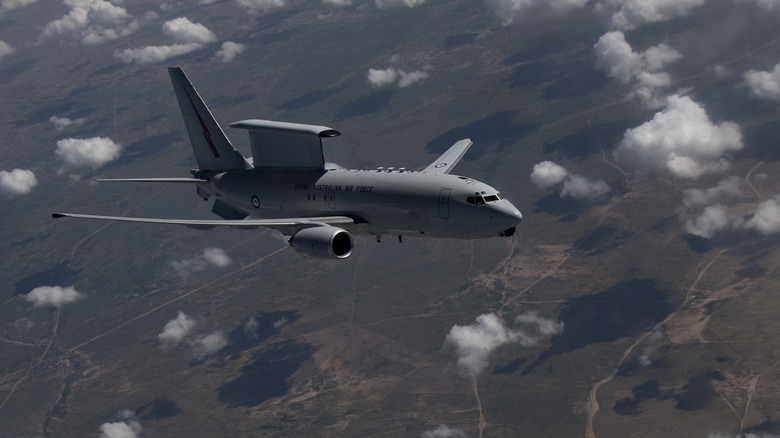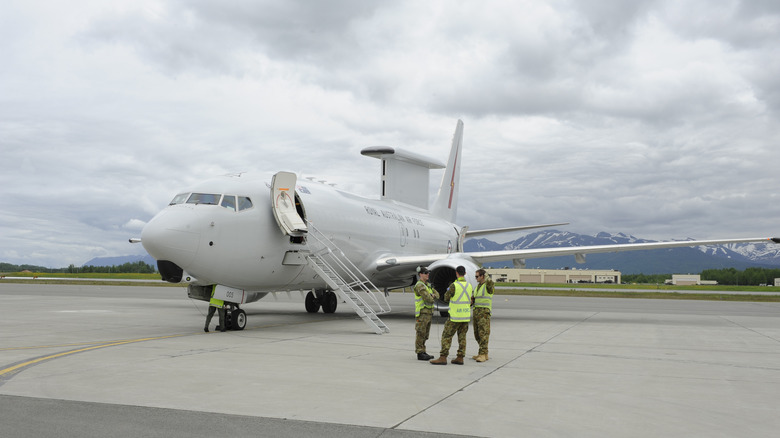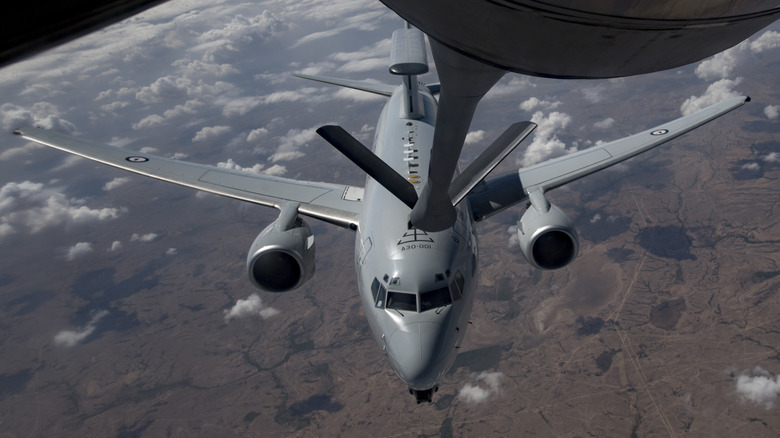The US Air Force Is Spending Billions On This Highly-Modified Boeing 737 Jet: Here's Why
As one of the world's most popular commercial jets, the Boeing 737 is a familiar name to travelers everywhere. For aviation enthusiasts, its narrow silhouette and the special flat-bottomed engines are instantly recognizable. But there's another group that's intimately acquainted with the 737: the U.S. military. Since 1973, the military has been using the 737 for various purposes, starting with the now-retired T-43 Gator trainer aircraft and currently including the C-40 Clipper for VIP transportation roles, ferrying U.S. military leaders and officials around the world.
The U.S. military's tie with the 737 family is set to become one league deeper with the billion-dollar contract for an advanced variant of the 737, called the E-7 AEW&C (Airborne Early Warning and Control). Given the name "Wedgetail" by the Royal Australian Air Force (RAAF), which commissioned Boeing to develop and later produce the aircraft in 1999, the E-7 was designed to serve as a radar plane for the RAAF, enhancing its airborne surveillance and early warning capabilities.
In 2022, the U.S. Air Force decided to adopt the E-7 as a replacement for its aging fleet of E-3 Sentry aircraft, which have symbolized American air superiority since 1977 with their distinctive rotating rotodome. So, what makes the E-7 so special that the Air Force is willing to pay so much money for each jet?
The Radar That's Capable of Staring
The success of an Airborne Early Warning & Control (AEW&C) aircraft largely depends on its "eye" – the radar. In this regard, the E-7 is a significant upgrade over the E-3 that it's set to replace.
The E-3's eye is the Westinghouse AN/APY-1/2 radar, housed in a massive 30-foot rotodome on top of the plane. While able to simultaneously track 600 targets in the air and at sea at once, the AN/APY-1/2 is limited by its old-fashioned mechanical design. The radar must physically spin to scan the azimuth, however, rotating at just six revolutions per minute, it updates a target's position at a glacial pace of once every 10 seconds. This makes the E-3 prone to losing very fast-moving objects like supersonic jets. If a jet closes in at Mach 2 (over 1,500 mph), it can travel four miles in the time it takes the radar to cycle back around. Such an exploitable blind spot could prove disastrous in future high-intensity conflicts.
The E-7's new Multi-Role Electronically Scanned Array (MESA) radar doesn't have this problem. As an electronically scanned array, it can scan the airspace without physically rotating. The exact refresh rate is classified but undoubtedly far exceeds the E-3's mechanical radar — where the old system merely glanced, the MESA stares. MESA can also dynamically focus on specific areas of the airspace to track potential air and sea targets with even greater accuracy and responsiveness, which is something the E-3 simply can't do.
More Utility and Survivability in a Smaller Package
The MESA radar array goes beyond just track-and-scan. It has an integrated Identification Friend or Foe (IFF) system to distinguish allied aircraft from hostile ones. There's also an Electronic Support Measure (ESM) package, which can analyze radar signals from the planes the E-7 spotted, match them to a database, and pinpoint the specific aircraft type. The older E-3 gained similar ESM capabilities through the Block 40/45 upgrade in 2016, but the E-7's newer sensors should be much better at the job.
The E-7 also has better survivability thanks to an electronic self-protection system (details undisclosed by Boeing) that the E-3 lacks. This, combined with the longer range of the E-7's advanced MESA radar, allows it to manage the airspace and direct friendly aircraft from safer stand-off distances.
Perhaps the E-7's most compelling advantage over the E-3 is that it's built on Boeing's more modern 737 Next-Generation commercial airframe. Though it's been replaced by the troubled 737 MAX, the supply chain for the 737NG remains robust, with many airlines in the world still flying this type today. That can't be said for the 707 upon which the E-3 was based, nor the half-century-old TF33 turbofans that power the aircraft. Maintenance of the E-3 was so challenging that the fleet was frequently grounded due to numerous problems, including part shortages. Adopting the E-7 provides not just enhanced capabilities but also economic benefits through a more sustainable airframe and supply chain (at least on paper.)
The State of the Wedgetail
With the aging E-3 Sentry nearing retirement and the E-7 Wedgetail emerging as perhaps the most capable airborne early warning and control (AEW&C) aircraft available today (already in service with Australia, South Korea, and Turkey), the U.S. Air Force decided to take the pragmatic path of simply procuring the Wedgetail off-the-shelf rather than spending billions to develop an all-new platform from scratch. It also makes interoperability with U.S. allies easier, with everyone — from NATO to the strategic AUKUS alliance (both of which have committed to using the E-7) — using the same Command and Control Battle Management (C2BM) system.
Besides awarding Boeing a $1.2 billion contract in 2023 to begin production, the Air Force has already earmarked funding for the E-7 in its budget request for fiscal year 2025. However, official negotiations remain stalled on pricing details, with the Air Force finding Boeing's proposed unit cost unaffordable. The impasse may push back the delivery of prototypes by a year, according to Air Force Secretary Frank Kendall. Among the many reasons for the higher cost is the Air Force's requirement that the E-7 must come with the latest communication systems.
Currently, the Air Force plans to field 26 Wedgetails, a number close to the 32 E-3 Sentries once in service at the program's height. Though a slightly smaller fleet, the E-7's far superior radar and computer system should allow it to handle the mission scope as capably as the E-3s — potentially even more efficiently, too!



